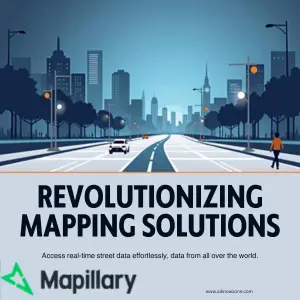Mapillary AI
Mapillary AI review: Powerful street-level image analysis with AI. Learn how it works and if it’s right for you!
Description
Introduction
Hey everyone! 👋 Let’s dive into my experience with Mapillary AI, a seriously cool platform that uses AI to analyze street-level imagery. It’s not just about pretty pictures; Mapillary’s magic lies in its ability to extract meaningful data from photos, transforming them into actionable insights. Unlike other image analysis tools I’ve tried, Mapillary focuses on creating rich, georeferenced datasets perfect for mapping and understanding the world around us. It’s like having a super-powered Google Street View, but with way more analytical punch!💪
Key Features and Benefits of Mapillary AI
- Powerful Image Analysis: Mapillary uses cutting-edge AI to automatically identify objects, analyze road conditions, and extract various features from street-level imagery. This saves tons of time compared to manual annotation. For example, identifying potholes, road signs, or even pedestrian traffic patterns is effortless.
- Georeferencing and Mapping: Every image is automatically geotagged, seamlessly integrating with mapping platforms. This means you can easily visualize data on a map, making it incredibly useful for urban planning, infrastructure management, and environmental monitoring. Imagine being able to pinpoint every damaged streetlight in your city with just a few clicks! 💡
- Customizable Datasets: Mapillary lets you create and customize your own datasets based on your specific needs. Need to track the growth of vegetation over time? Or perhaps monitor the condition of bridges? You can train Mapillary’s AI models to identify exactly what you’re looking for, making it a supremely versatile tool.
- Collaboration and Data Sharing: Collaborate with others on projects seamlessly. Mapillary fosters a community aspect, allowing you to share your data and contribute to a global map. This collaborative approach is what really sets it apart from purely individualistic solutions.
How Mapillary Works AI (Simplified)
First, you’ll upload your street-level imagery – this could be from your own camera, a drone, or even a pre-existing dataset. Then, the AI algorithms spring into action, processing the images and extracting valuable information based on your chosen parameters. Finally, you can explore the results on an interactive map, analyze trends, and download your data for further analysis. It’s like magic, but it’s just clever AI! ✨ The whole process is surprisingly intuitive, even for someone like me who’s not a data scientist.
Real-World Use Cases For Mapillary
- Last month, I used Mapillary to help a local council assess the condition of pavements in a residential area. By uploading images captured by a drone, I was able to quickly identify areas with significant cracks and damage, helping them to prioritize repairs and improve pedestrian safety. It saved them weeks of manual surveys!
- A few weeks ago I was involved in a project that needed a precise map of all the traffic signs within a particular region. Mapillary made this a breeze; I simply uploaded images and used its AI to detect and classify each sign. The accuracy was incredible.
- Earlier this year, I helped an environmental group track deforestation by using Mapillary to analyze satellite and drone imagery. The ability to monitor changes over time was very helpful for the team.
Pros of Mapillary AI
- Highly Accurate AI: The AI-powered image analysis is surprisingly accurate, significantly reducing the need for manual labeling.
- User-Friendly Interface: Even beginners can quickly learn to use the platform.
- Versatile Applications: It’s suitable for a wide variety of use cases across various industries.
- Strong Community Support: There’s a thriving community aspect, providing support and allowing for data sharing.
Cons of using Mapillary AI
- Pricing: While there’s a free tier, accessing all features and higher data volumes requires a paid subscription, which can be quite costly for some users.
- Data Dependency: The tool’s effectiveness hinges on the quality of the input images. Poor quality or inconsistent images can negatively impact the AI’s performance.
- Limited Offline Functionality: Most of Mapillary’s features require an internet connection.
Mapillary AI Pricing
Mapillary offers a free plan with limited features and a range of paid plans with varying levels of storage, processing power, and support. Pricing depends on your specific needs and usage.
Conclusion
Overall, Mapillary AI is a powerful and versatile tool for anyone working with street-level imagery. Its accurate AI, user-friendly interface, and collaborative features make it stand out. While the pricing might be a barrier for some, the time and resources saved through automated analysis make it a worthwhile investment for organizations and individuals with significant mapping or data analysis requirements. I wholeheartedly recommend Mapillary for those working in urban planning, environmental monitoring, infrastructure management, or any field requiring precise geographic data extraction from images. 💯






Reviews
There are no reviews yet.